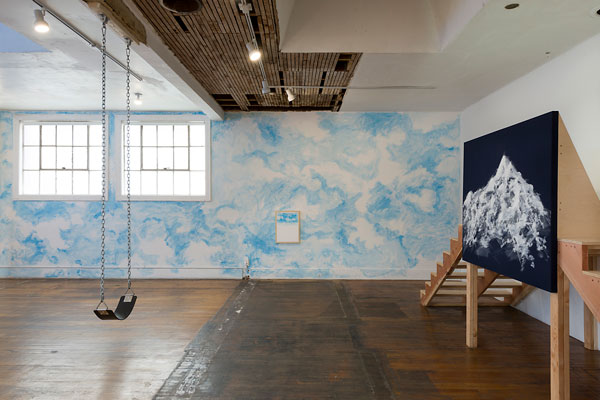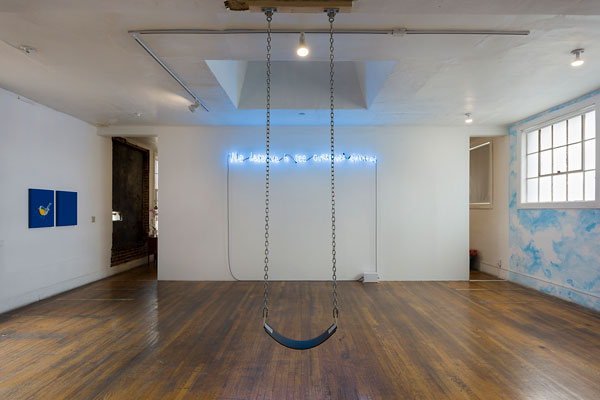Emblazoned in cursive neon light, the affirming phrase “we deserve to see ourselves elevated, as well as grounded” guides EJ Hill’s installation of objects and paintings, which structurally suggests both sublime ascension and children’s playgrounds. The locations of the words are split; in order to grasp the full context, the viewer must move through the entire space. The first portion “we deserve to see ourselves elevated” is set near the top of an empty wall, in the center of the gallery; facing this wall is a solitary swing and to the left, the wall is painted floor to ceiling with clouds and blue sky. The second portion of the phrase, “as well as grounded,” is inserted in the plateau of an allegorical mountain formed by two staircases connected by a small platform with a mountain painted on the facade.
Titled, “The Necessary Reconditioning of the Highly Deserving,” the work creates composed perspectives of elevation. The swing at its highest point reaches toward the neon script and the celestial top of the clouds. Yet these points of view are mutable, dependent on the position of the viewer and the swing, which naturally reverses direction, coming back toward the ground. The metaphoric mountain summit similarly creates a kinesthetically heightened viewpoint, with the stairs echoing the same rise and fall of the swing. While asserting a space of exaltation, the work also acknowledges its antithesis and possible impermanence. The words “elevated” and “grounded” also acknowledge opposites, forming a positive and balanced seat of empowerment, or reconditioning, as the exhibition title suggests. Additionally, the term “grounded,” and the neon light, adapt the linguistic and visual cues of electricity into further symbols of balance between protection and power.

EJ Hill, The Necessary Reconditioning of the Highly Deserving, 2017, installation view, ©EJ Hill, courtesy of the artist and Commonwealth and Council, photo by Ruben Diaz.
Hill has gained recognition for endurance-based performances, and this work noticeably diverges from his existing oeuvre through the absence of his body. Yet performance is not completely removed: the installation of objects and paintings contains two modes of presence, one as static forms, and one activated by the viewers’ participation, mobilizing the swing and the mountain steps. In a reversal of roles, the viewer becomes the performing subject, navigating their position within these spaces of elevation and de-elevation.
Hill’s new direction is finessed while also exuding experimentation, in both exciting and uncertain ways. It is evident he is taking risks in his work, and certain portions of the exhibition contribute more than others. For example, there are three small paintings, of a mountain, a bird, and a blue color-field, that get lost in the larger installation. The neon text also reads as too directive in contrast to the non-linear playfulness and mobile freedom symbolized through the playground-inspired installation.
Yet overall it is an opportune and provocative departure. The radically encouraging installation creates a complex interaction between absence and presence that breaks with prescribed meanings of the singular performing body. It affirms absence as an important aesthetic strategy, particularly as it resists canonized prescriptions of the body in performance art. Hill’s explorations are a promising venture as he continues to reconsider the role of the performer and the viewer.


